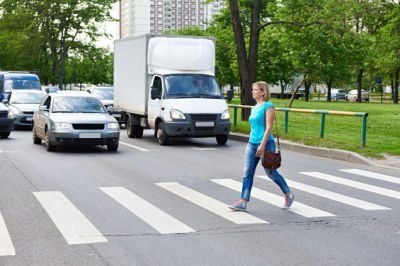What Kind of Legal Rights Do I Have As a Pedestrian in California?

San Diego is only pedestrian-friendly downtown, and it’s frustrating and possibly frightening to share the streets with so many drivers. You may enjoy walking for your health, the environment, or wallet. No matter the reason, you have the right to use public roadways for safe travel.The Freedom to Walk pedestrian law is effective as of January 1, 2023. Now, more than ever, we need to know our right-of-way laws if we’re involved in a pedestrian accident. Reviewing your legal rights and responsibilities as a traveler on foot might be helpful.
Do Pedestrians Always Have the Right-of-Way?
Traffic laws in California favor the person walking. While pedestrians and drivers are equal in the eyes of the law, the size and speed of cars give them the advantage in pedestrian-motor vehicle collisions. Pedestrian fatalities can result in criminal charges for the driver of a vehicle, so the personal injury lawyers of Mova Law Group – Personal Injury Attorneys advise you to be safe rather than having to deal with a wrongful death claim. Practice pedestrian safety so you can avoid high medical bills and severe injuries.
Pedestrians are anyone traveling via foot, mobility devices, or self-propelled transport. This includes:
- Skateboards.
- Manual scooters (not electric ones).
- Rollerblades.
- Those on crutches or in wheelchairs.
- Mobility scooters.
Bicyclists are also a separate entity and have their own rules to follow. Pedestrians have the right-of-way over motorists in marked crosswalks and when the traffic signals give them the green light. Not only that, but pedestrian right-of-way applies to unmarked crosswalks as well.
California Vehicle Codes Regarding Pedestrian Right-of-Way
Travelers on foot have the right to use the sidewalks along roads and be safe from harm, according to California vehicle code. Some of your rights according to pedestrian laws include:
- A pedestrian crossing at traffic lights, stop signs, or crosswalks always has the right of way.
- Marked crosswalks have visible lines and a stop sign or traffic control signals.
- Unmarked crosswalks may be anywhere on the road rather than at an intersection.
- Motorists may not stop in a crosswalk.
- Cars cannot pass other cars stopped at a crosswalk (vehicles may interfere with visibility).
- Cars stopping at a red light must give 5 feet of space to those crossing.
- Cars cannot drive on sidewalks unless entering a parking lot or alley and must yield to foot traffic on these turns.
- Blind pedestrians with walking sticks or guide dogs have the right-of-way at all intersections as per White Cane laws.
Some exceptions to your rights as a pedestrian include these rules:
- You must yield the right-of-way if instructed by law enforcement, even with a walk signal (i.e., traffic control devices stopped and police are directing traffic).
- Pedestrians give up their right-of-way if they walk on the side of the road on major highways and other busy, prohibited lanes.
- People on foot must stay out of bicycle lanes except to avoid an obstacle.
What is California’s New Jaywalking Law?
As of January 1, 2023, pedestrians may cross a street at any unmarked crosswalk without getting a citation, per the Freedom to Walk Act. This rule aims to reduce the unfair ticketing of people of color for mild infractions such as jaywalking.
This jaywalking law means that we all must pay closer attention to our surroundings. A jaywalker may give a motorist little time to slow down. To practice due care, the pedestrian accident lawyers of Mova Law Group – Personal Injury Attorneys recommend staying off smartphones and enjoying your surroundings while walking.
What Happens if a Pedestrian Causes a Car Accident?
While a driver has greater due care than a pedestrian, it doesn’t mean they’re responsible for a crash. Right-of-way protects you from criminal charges in an accident but doesn’t absolve fault. Pedestrians are better off never assuming they have it and always paying attention to their surroundings.
When might a pedestrian be responsible for a car accident?
- They didn’t use a crosswalk or didn’t obey traffic signals.
- The pedestrian darted onto a street into oncoming traffic.
- The person on foot is walking on a roadway off limits to pedestrians.
- They are on the road while impaired by drugs or alcohol.
Even legally jaywalking, pedestrians must yield, especially to any oncoming vehicles. A driver has to react quickly to avoid an accident when someone emerges from between parked cars, presenting an immediate hazard. Motorists may swerve off the road, veer into a lane beside them, or into oncoming traffic to avoid the pedestrian and end up in a different car accident. A pedestrian accident attorney from Mova Law Group – Personal Injury Attorneys can help you after a collision, whether you were the person on foot or the driver. Contact our law firm today for a free consultation to review your potential personal injury claim.
Personal Injury Attorneys Help Determine Comparative Carelessness
California’s fault laws allow multiple parties to be liable for accidents. If a driver is speeding, but the pedestrian crosses on a ‘Don’t Walk’ signal, they both might have violated their due care. Insurance companies and personal injury attorneys will negotiate each party’s responsibility percentage (comparative carelessness). This percentage of contributory negligence determines the amount of damages they owe.
If you or a loved one get in a pedestrian accident, contact Mova Law Group – Personal Injury Attorneys law firm today and speak to a comparative carelessness expert. We will review your case during our initial free consultation and advise you of your claim’s viability and expected settlement value. We take personal injury cases on a contingency fee basis, so you only pay once we win the settlement you’re happy with. No matter your role in a person vs. car accident, Mova Law Group – Personal Injury Attorneys will represent you and get the compensation you deserve.
Ready to Start? Contact Us Today!
(858) 333-4999